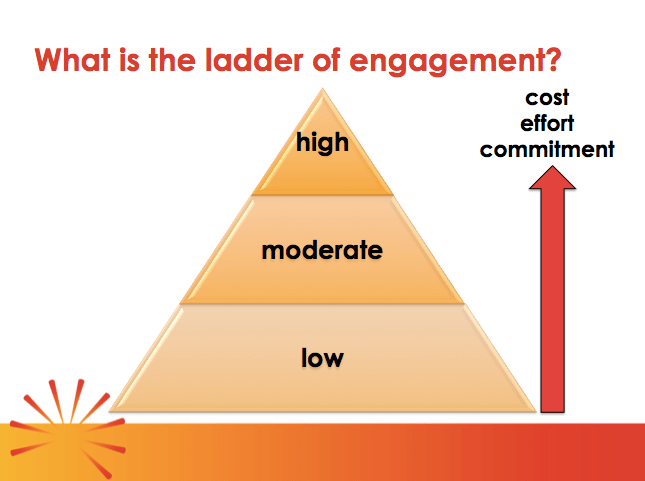
No, I’m not going to get into which white-label platform you should use – for that, we have ReviewMyCommunity.
Take one step back: white-label or public?
That is, the publicly-available, commercial platforms (LinkedIn, Facebook, and their ilk).
This is a tough one.
The advantage – and it’s a BIG one – of using a public platform is that your members are already there. They already know how to access the site. They already have an account. They already know how to use the site. They already log in on a regular basis.
That’s significant.
Your members are experiencing platform fatigue. They don’t want to create another account whose password they’re going to forget. They don’t want to have to learn another interface. They don’t want to have to remember to check another website. They’re overloaded with information and looking to simplify.
On the other hand, if it’s free, you’re the product.
You don’t pay for that platform which means, as many of us have discovered to our great sorrow over the years, they can change the rules at any time, in any way, with any – or no – warning.
When Facebook first started breaking out from being just a place where college kids and young adults went to “poke” each other and play FarmVille, associations went big on the platform, investing time and resources in developing our organizational pages, and getting good results – fans, likes, driving traffic back to our main websites.
But Facebook couldn’t profit off that exposure, so they changed the rules to decrease organizations’ visibility in our audiences’ timelines. Unless you pay.
Thus began a war of attrition between Facebook and organizations trying to use Facebook for audience outreach, where we start enjoying success that isn’t filling Facebook’s coffers, so they change the rules, so our “reach” drops off, so we either pay the protection money or figure out a way around the new rule changes until Facebook catches up with us and changes the rules AGAIN.
LinkedIn, being the business platform, cut straight to the chase, and for all intents and purposes, killed Groups in 2017. I mean, they still exist, but they’re buried and a lot of the functionality has been stripped. LinkedIn’s energy seems to be going towards having your feed be the locus of interaction (like Facebook), but somehow I don’t think this blog post (which will auto-post to my LI feed) is going to be nearly as compelling as latest viral cat video or meme on Facebook.
You don’t own the data from that platform – they do. Can you download contact information for members of your LinkedIn Group? Nope. You appear to be able to, for Facebook, at least right now and for some types of groups. But that may change in the 15 minutes from when I type this until I hit “publish” on this post. And you don’t own any data, information, insights, etc. that are shared in your groups on either platform.
Additionally, although your members may be on a particular platform, they may not want to be WITH YOUR ASSOCIATION on that platform. You have a better shot here with LinkedIn, of course, but it’s pretty common for people to use the other platforms solely for personal reasons, which means they may not want to connect with you at all, or even if they do, they may not want to interact with your content there.
So why is this even a question? Just get Higher Logic or Breezio or whatever and be done with it.
That’s not that simple, either. Aside from cost issues, there’s a flywheel effect. Getting an online community started from scratch is really hard. In order for people to want to come, there has to be some “there” there, but there won’t be useful content without active contributors.
Chicken and egg? Yep.
I will say, all of the community platform vendors that have been successful in the association space are well aware of this problem, and offer all sorts of resources and guides and tips and assistance to their clients in getting the machine going.
But you still have to assess things like:
Overall size of your audience. Online communities are subject to the 90-9-1 rule. That is, 90% are going to lurk nearly exclusively. Nine percent will contribute occasionally. One percent will be truly active.
Math problem (don’t worry – it’s easy): What’s the overall size of your audience?
If you have 100,000 community members, you’re in good shape – that’s a lot of lurkers, but it’s also 1,000 active contributors and 9,000 occasional contributors, which is PLENTY to generate robust conversation.
Now if your total audience is 1000 – or 500 – or 100 – your white-label online community may NEVER take off. Too few contributors. It’s just math.
Their comfort level with technology, and the user interface and experience of the technology undergirding the platform you choose. All the respected platforms support Single Sign-On (SSO) at this point, but are your members even comfortable with logging into your website in the first place? Are they going to be willing and able to put in the time to learn what your community platform can do? Are they going to be savvy enough not to kill conversation with a constant flood of “me, too” posts? Will the platform allow them to interact in the way(s) they want, which at a minimum should include: website that is responsive design (so it works equally well on a computer, tablet, or smartphone), email, and app?
Their work environments and patterns. Are they people who are online for their jobs or at their jobs? Is that where they go to get advice, or do they turn to the person next to them? Do they like typing responses back and forth on an open platform, or are they more comfortable on the phone – or texting – with individuals or a small, select group?
There’s no one right answer for every association or for every industry or profession. For some, a private community is going to be worth the investment of association resources (not just buying the technology, but also staff time and attention to nurture your new community) and the learning curve for the members.
For some, the drawbacks of Facebook or LinkedIn will be far outweighed by the convenience, ease, and cost (or lack thereof) of these platforms.
Some groups may not benefit from an online community, no matter what the platform – they may be more suited to facilitating one-on-one or small group relationships.
Remember, associations are about community, about groups of people coming together to accomplish things they couldn’t do at all – or at least not as well or easily – on their own. What best helps your particular people achieve that goal?
Know yourself, know your industry or profession, know your members – and don’t be distracted by the new, shiny, hot thing everyone’s fangirling over this week.
Edited to add: The September/October 2019 issue of CalSAE’s The Executive magazine includes an excellent article on just this topic! Check it out!
Photo by Naassom Azevedo on Unsplash









